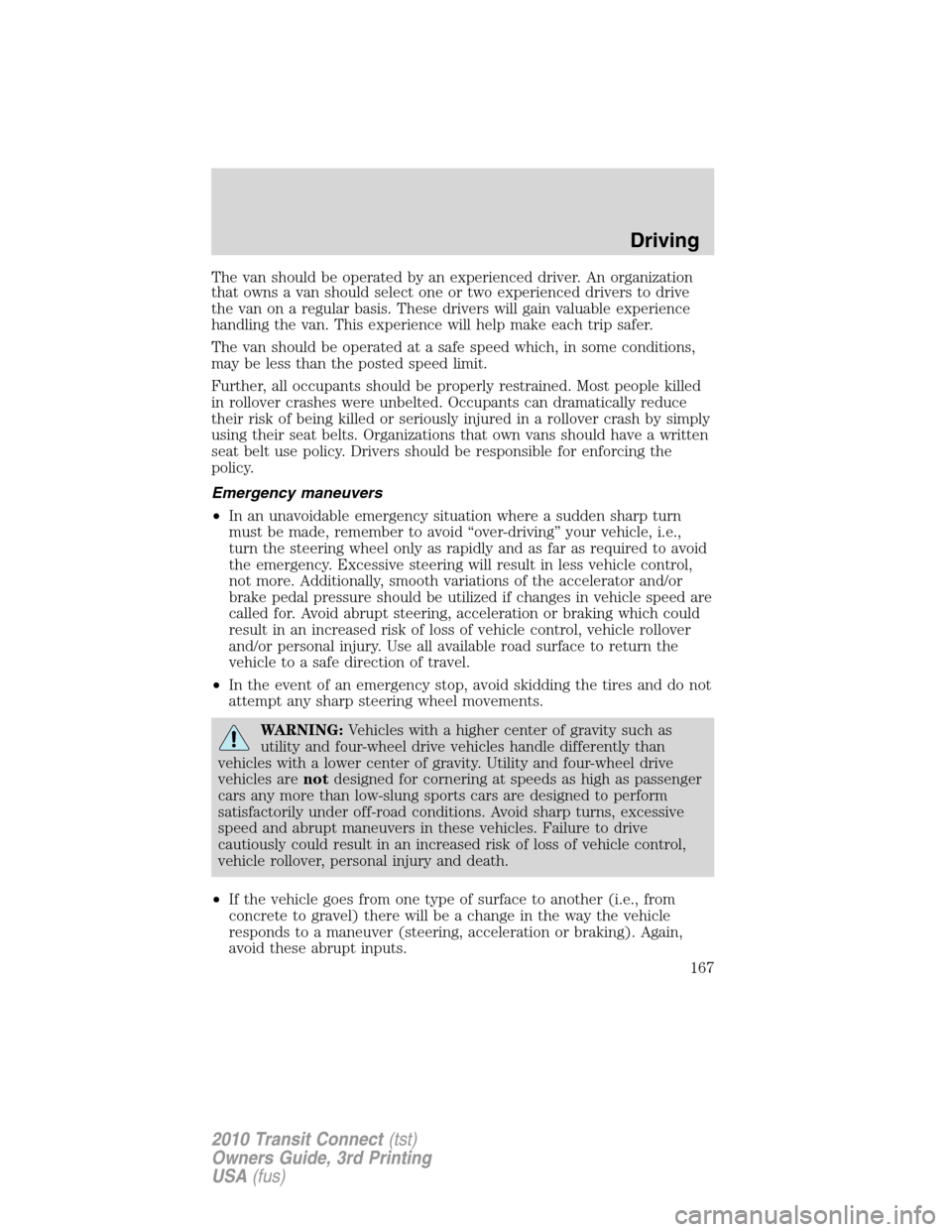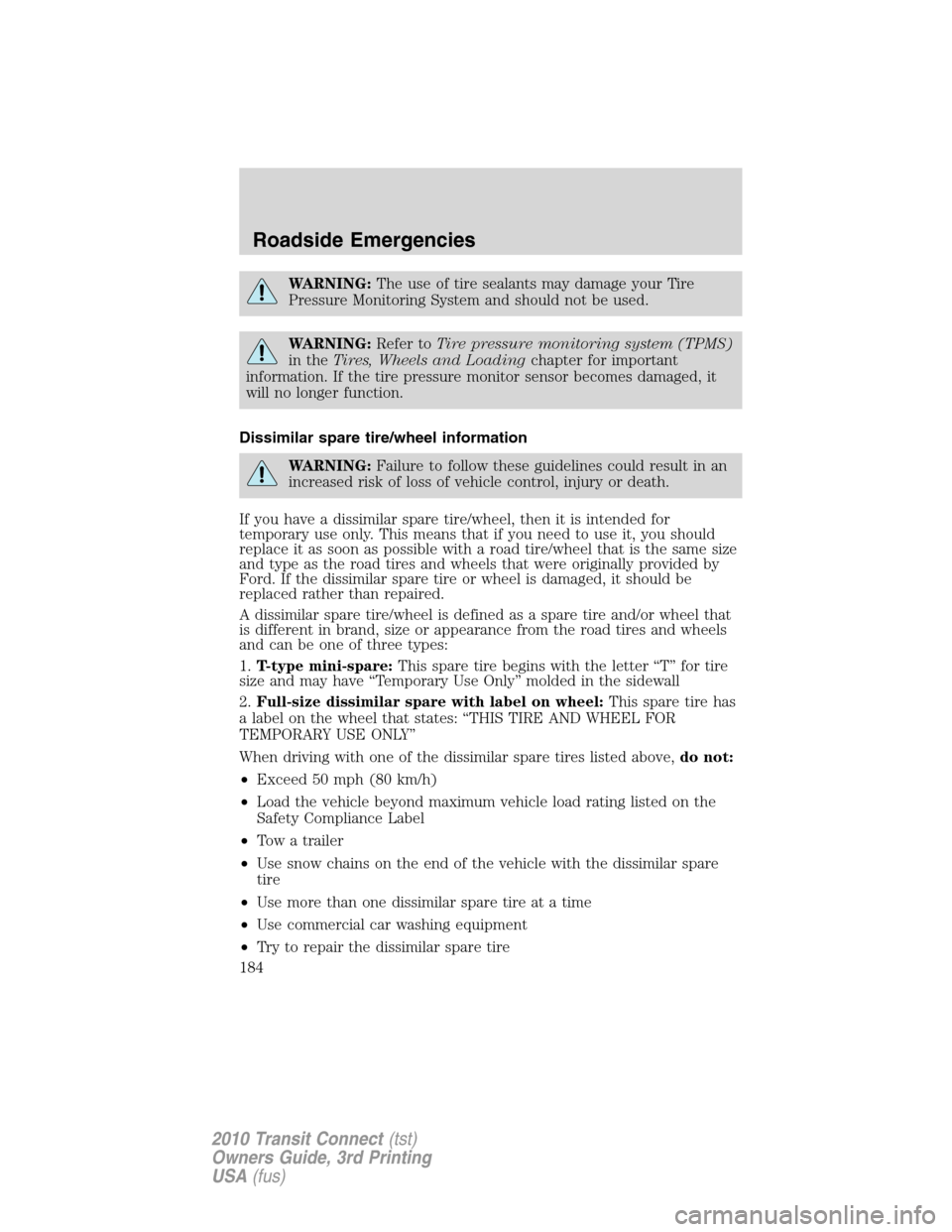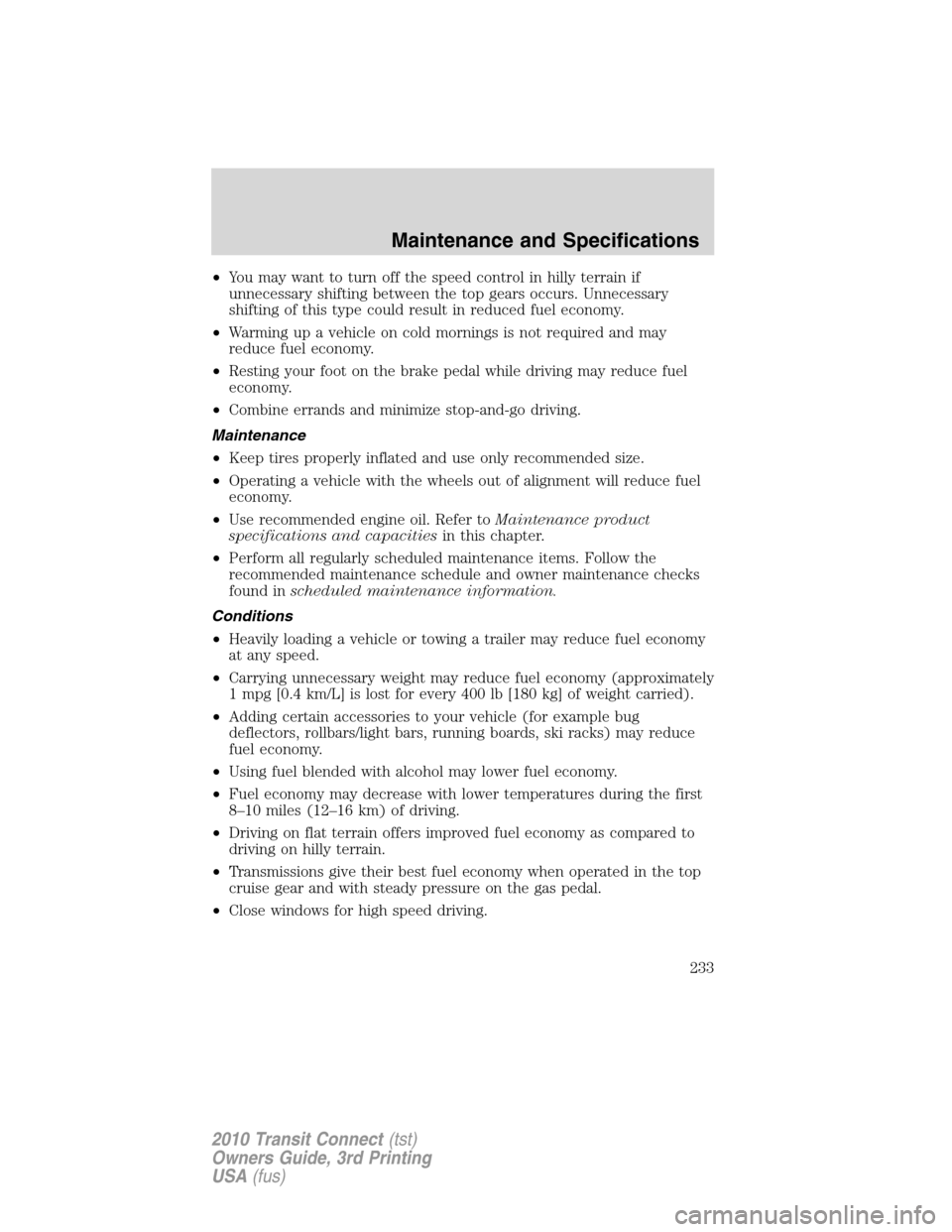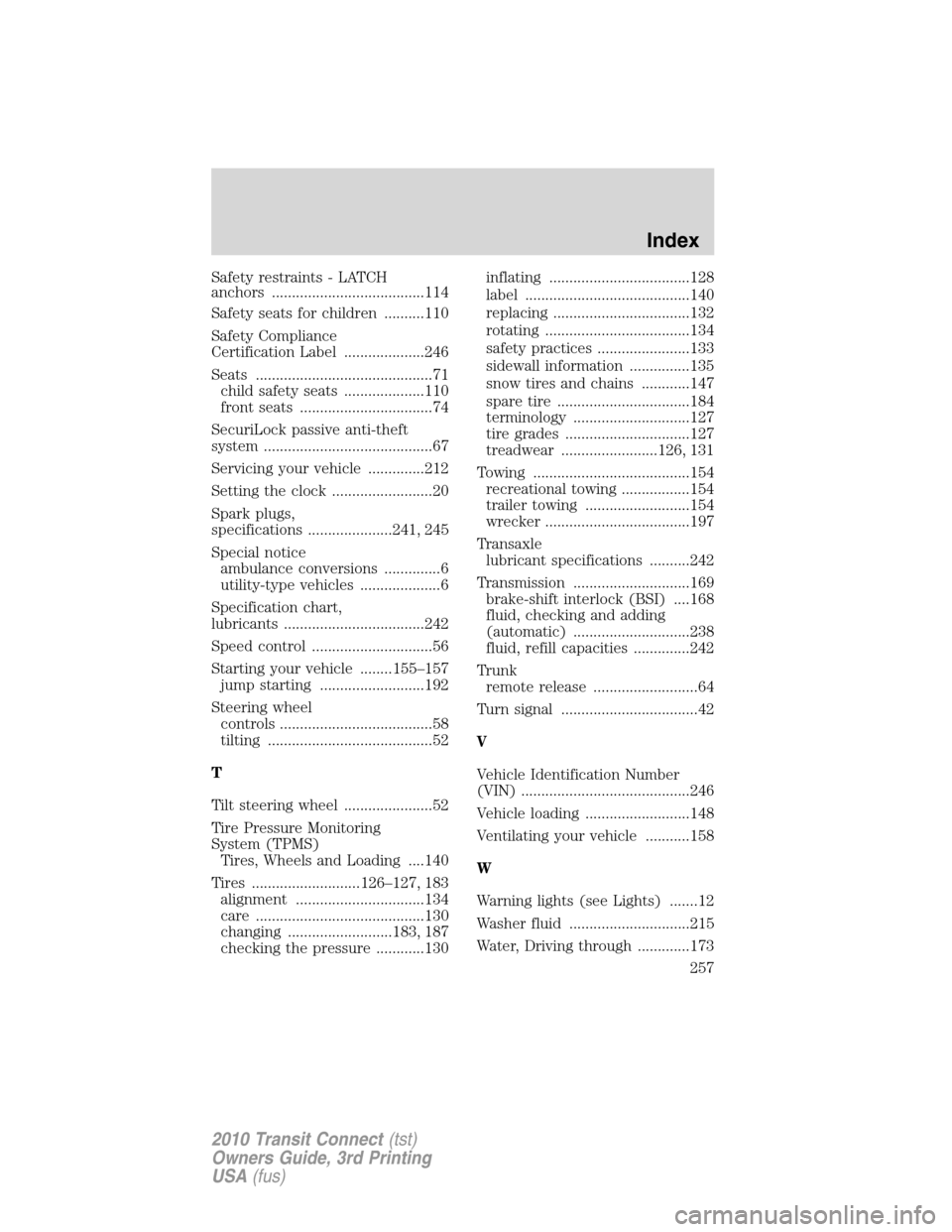tire type FORD TRANSIT CONNECT 2010 1.G User Guide
[x] Cancel search | Manufacturer: FORD, Model Year: 2010, Model line: TRANSIT CONNECT, Model: FORD TRANSIT CONNECT 2010 1.GPages: 258, PDF Size: 1.98 MB
Page 167 of 258

The van should be operated by an experienced driver. An organization
that owns a van should select one or two experienced drivers to drive
the van on a regular basis. These drivers will gain valuable experience
handling the van. This experience will help make each trip safer.
The van should be operated at a safe speed which, in some conditions,
may be less than the posted speed limit.
Further, all occupants should be properly restrained. Most people killed
in rollover crashes were unbelted. Occupants can dramatically reduce
their risk of being killed or seriously injured in a rollover crash by simply
using their seat belts. Organizations that own vans should have a written
seat belt use policy. Drivers should be responsible for enforcing the
policy.
Emergency maneuvers
•In an unavoidable emergency situation where a sudden sharp turn
must be made, remember to avoid “over-driving” your vehicle, i.e.,
turn the steering wheel only as rapidly and as far as required to avoid
the emergency. Excessive steering will result in less vehicle control,
not more. Additionally, smooth variations of the accelerator and/or
brake pedal pressure should be utilized if changes in vehicle speed are
called for. Avoid abrupt steering, acceleration or braking which could
result in an increased risk of loss of vehicle control, vehicle rollover
and/or personal injury. Use all available road surface to return the
vehicle to a safe direction of travel.
•In the event of an emergency stop, avoid skidding the tires and do not
attempt any sharp steering wheel movements.
WARNING:Vehicles with a higher center of gravity such as
utility and four-wheel drive vehicles handle differently than
vehicles with a lower center of gravity. Utility and four-wheel drive
vehicles arenotdesigned for cornering at speeds as high as passenger
cars any more than low-slung sports cars are designed to perform
satisfactorily under off-road conditions. Avoid sharp turns, excessive
speed and abrupt maneuvers in these vehicles. Failure to drive
cautiously could result in an increased risk of loss of vehicle control,
vehicle rollover, personal injury and death.
•If the vehicle goes from one type of surface to another (i.e., from
concrete to gravel) there will be a change in the way the vehicle
responds to a maneuver (steering, acceleration or braking). Again,
avoid these abrupt inputs.
Driving
167
2010 Transit Connect(tst)
Owners Guide, 3rd Printing
USA(fus)
Page 184 of 258

WARNING:The use of tire sealants may damage your Tire
Pressure Monitoring System and should not be used.
WARNING:Refer toTire pressure monitoring system (TPMS)
in theTires, Wheels and Loadingchapter for important
information. If the tire pressure monitor sensor becomes damaged, it
will no longer function.
Dissimilar spare tire/wheel information
WARNING:Failure to follow these guidelines could result in an
increased risk of loss of vehicle control, injury or death.
If you have a dissimilar spare tire/wheel, then it is intended for
temporary use only. This means that if you need to use it, you should
replace it as soon as possible with a road tire/wheel that is the same size
and type as the road tires and wheels that were originally provided by
Ford. If the dissimilar spare tire or wheel is damaged, it should be
replaced rather than repaired.
A dissimilar spare tire/wheel is defined as a spare tire and/or wheel that
is different in brand, size or appearance from the road tires and wheels
and can be one of three types:
1.T-type mini-spare:This spare tire begins with the letter “T” for tire
size and may have “Temporary Use Only” molded in the sidewall
2.Full-size dissimilar spare with label on wheel:This spare tire has
a label on the wheel that states: “THIS TIRE AND WHEEL FOR
TEMPORARY USE ONLY”
When driving with one of the dissimilar spare tires listed above,do not:
•Exceed 50 mph (80 km/h)
•Load the vehicle beyond maximum vehicle load rating listed on the
Safety Compliance Label
•Tow a trailer
•Use snow chains on the end of the vehicle with the dissimilar spare
tire
•Use more than one dissimilar spare tire at a time
•Use commercial car washing equipment
•Try to repair the dissimilar spare tire
Roadside Emergencies
184
2010 Transit Connect(tst)
Owners Guide, 3rd Printing
USA(fus)
Page 233 of 258

•You may want to turn off the speed control in hilly terrain if
unnecessary shifting between the top gears occurs. Unnecessary
shifting of this type could result in reduced fuel economy.
•Warming up a vehicle on cold mornings is not required and may
reduce fuel economy.
•Resting your foot on the brake pedal while driving may reduce fuel
economy.
•Combine errands and minimize stop-and-go driving.
Maintenance
•Keep tires properly inflated and use only recommended size.
•Operating a vehicle with the wheels out of alignment will reduce fuel
economy.
•Use recommended engine oil. Refer toMaintenance product
specifications and capacitiesin this chapter.
•Perform all regularly scheduled maintenance items. Follow the
recommended maintenance schedule and owner maintenance checks
found inscheduled maintenance information.
Conditions
•Heavily loading a vehicle or towing a trailer may reduce fuel economy
at any speed.
•Carrying unnecessary weight may reduce fuel economy (approximately
1 mpg [0.4 km/L] is lost for every 400 lb [180 kg] of weight carried).
•Adding certain accessories to your vehicle (for example bug
deflectors, rollbars/light bars, running boards, ski racks) may reduce
fuel economy.
•Using fuel blended with alcohol may lower fuel economy.
•Fuel economy may decrease with lower temperatures during the first
8–10 miles (12–16 km) of driving.
•Driving on flat terrain offers improved fuel economy as compared to
driving on hilly terrain.
•Transmissions give their best fuel economy when operated in the top
cruise gear and with steady pressure on the gas pedal.
•Close windows for high speed driving.
Maintenance and Specifications
233
2010 Transit Connect(tst)
Owners Guide, 3rd Printing
USA(fus)
Page 257 of 258

Safety restraints - LATCH
anchors ......................................114
Safety seats for children ..........110
Safety Compliance
Certification Label ....................246
Seats ............................................71
child safety seats ....................110
front seats .................................74
SecuriLock passive anti-theft
system ..........................................67
Servicing your vehicle ..............212
Setting the clock .........................20
Spark plugs,
specifications .....................241, 245
Special notice
ambulance conversions ..............6
utility-type vehicles ....................6
Specification chart,
lubricants ...................................242
Speed control ..............................56
Starting your vehicle ........155–157
jump starting ..........................192
Steering wheel
controls ......................................58
tilting .........................................52
T
Tilt steering wheel ......................52
Tire Pressure Monitoring
System (TPMS)
Tires, Wheels and Loading ....140
Tires ...........................126–127, 183
alignment ................................134
care ..........................................130
changing ..........................183, 187
checking the pressure ............130inflating ...................................128
label .........................................140
replacing ..................................132
rotating ....................................134
safety practices .......................133
sidewall information ...............135
snow tires and chains ............147
spare tire .................................184
terminology .............................127
tire grades ...............................127
treadwear ........................126, 131
Towing .......................................154
recreational towing .................154
trailer towing ..........................154
wrecker ....................................197
Transaxle
lubricant specifications ..........242
Transmission .............................169
brake-shift interlock (BSI) ....168
fluid, checking and adding
(automatic) .............................238
fluid, refill capacities ..............242
Trunk
remote release ..........................64
Turn signal ..................................42
V
Vehicle Identification Number
(VIN) ..........................................246
Vehicle loading ..........................148
Ventilating your vehicle ...........158
W
Warning lights (see Lights) .......12
Washer fluid ..............................215
Water, Driving through .............173
Index
257
2010 Transit Connect(tst)
Owners Guide, 3rd Printing
USA(fus)